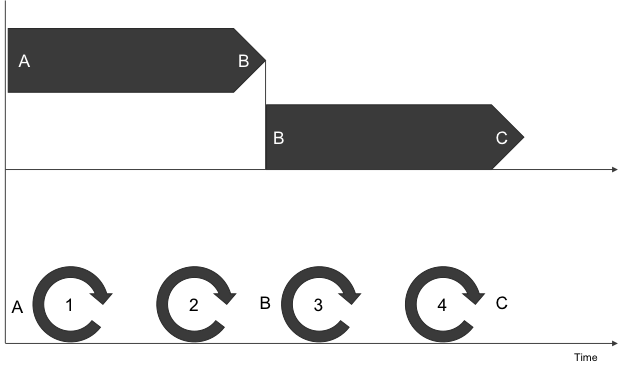Going in Circles?
In the age of Agile, it is all too easy to forget about basic Lean Thinking.
If you present a project proposal with a time plan showing two horizontal arrows, the first one going from A to target B, and the second one going from B to target C, chances are that somebody in your audience will have a comment.
“Shouldn’t we do this in an agile fashion, this looks very waterfall to me?” Or, somebody else will ask: “Can’t we start to work on C in parallel?”

If you had instead shown a project plan with four circular arrows depicting agile sprints in a line from A via B to C, probably everybody would have thought the plan is fine.
The Boy Who Cried Agile
But what’s really going on here? Isn’t a straight line the quickest way to get from A to B anymore? What was it they were really commenting on? It is a classic case of The Boy Who Cried Wolf! We demand “agile” all the time – but when it is really needed, we don’t know what to do and so we keep running in circles.
The real questions to review our project proposal on how to get from A to C are:
- Do we really need (all of) B and C and do we understand well enough their scope?
And if Yes,
- How can we reduce the throughput times?
- How much of B do we need before we can start working on C?
Let’s assume we understand the scope of B and C well enough. How do we reduce the throughput times? By iterations and sprints?
No. We only achieve it by:
- Assigning enough resources: a dedicated team with qualified people having no other mission than to get from A to B and then to C as quickly as possible, and with no other assignments to worry about.
- Having a governance structure in place that allows for fast decision-making, without waiting for the next steering meeting in two months.
Should we start working on C before B is ready?
Yes, if we have dedicated teams for both tracks, it might reduce time – but only if we understand and can manage the dependencies in a smart way. However, managing dependencies is in any case an overhead cost, so why not put all resources working on B and get it done asap?
Don’t Go Chasing Waterfalls
When aiming for agility, we seem to forget the basics: Lean thinking. With Lean, you mainly focus on optimizing flow – that is reducing the throughput time of your project – rather than optimizing your resource utilization. A system with fluctuating demand and 100% resource utilization has long lead times.
So, when you see a project plan that looks like a waterfall, remember:
- The quickest path between two points is still a straight line: do not iterate for the sake of iterating. One thing at a time and as soon as possible, is more effective.
- Dedicated resources are essential for quick throughput times: avoid multi-tasking and put flow optimization above resource utilization.
- Ensure fast decision-making, either by empowerment or a really engaged steering committee.
About the author:
Menno Huijben is a Senior Executive at Sofigate and a concept owner of Business Technology Transformations and Data Leadership.
Menno is interested in the realm of decision-making in business, especially where data-driven meets intuition and experience. His motto is ” Don’t forget the Human Factor “


